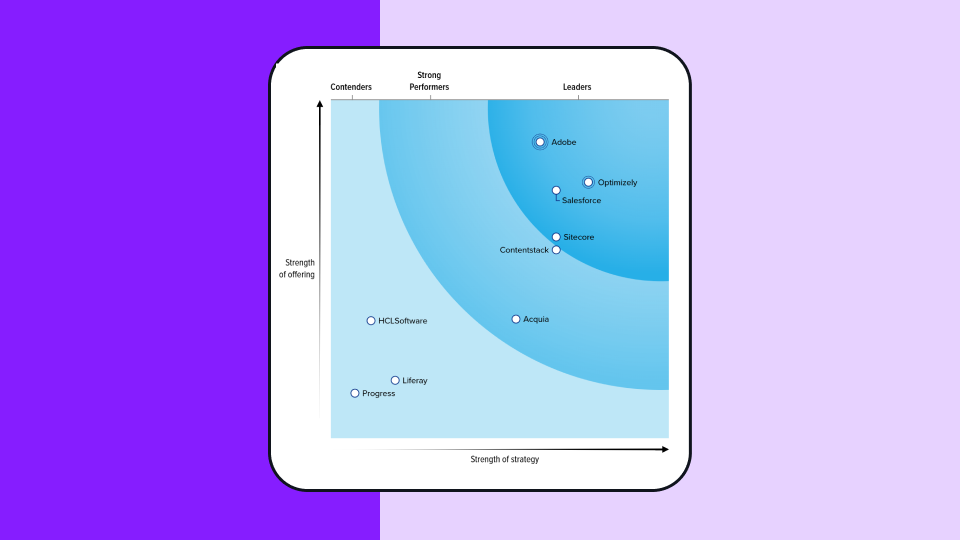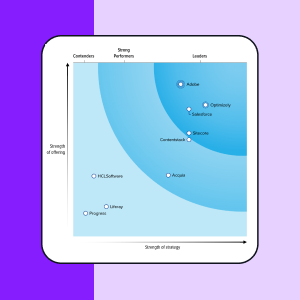Återanvändning av innehåll
Vad är återanvändning av innehåll?
Återanvändning av innehåll innebär att man återvinner, återanvänder och till och med räddar ett befintligt innehåll genom att publicera det på nytt i ett annat format till nya målgrupper i olika kanaler. Vad det inte innebär är att helt enkelt återutge samma innehåll. Och det betyder definitivt inte att man lånar innehåll från ett annat varumärke och publicerar det som sitt eget.
Kolla in vår ultimata guide till återanvändning av innehåll för att ta reda på fördelarna, hur man återanvänder innehåll effektivt, hur man väljer vad man ska återanvända och de bästa verktygen för det.
Varför har återanvändning av innehåll blivit så populärt?
Publiken är mer innehållshungrig än någonsin. På resan mot att skapa allt djupare kontakter med kunderna är det uppenbara svaret att öka innehållsproduktionen. Men vi vet alla hur mycket tid, ansträngning och kostnader som går åt för att skapa en enda högkvalitativ text-, video- eller ljudtillgång. Så vilket slöseri att bara använda det en gång.
Återanvändning av innehåll erbjuder ett enklare, billigare och smartare alternativ till den traditionella metoden skapa-publicera-glöm. Genom att skapa nya, kanalspecifika versioner av bra innehåll kan du förlänga dess livscykel, arbeta smartare och få ut mesta möjliga värde av resurser som du redan har publicerat.
Vilken typ av innehåll bör du återanvända?
Det säger sig självt att det inte är allt innehåll som lämpar sig för återanvändning av innehåll. Till exempel kan allt som är kopplat till aktuella händelser eller kortsiktiga trender vara mycket användbart just nu, men det kommer inte att stå sig över tid och kommer snabbt att nå sitt bäst före-datum.
Så vilka innehåll fungerar? Evergreen content är en självklar plats att börja på. Evergreen-innehåll täcker ämnen som kommer att förbli relevanta på lång sikt. Fallstudier, "hur man gör"-videor, checklistor för processer, guider, vanliga frågor och ordlistor är alla bra exempel på innehåll som fortsätter att erbjuda värde för dina kunder över tid.
En annan uppenbar källa till material är din pålitliga analytics dashboard. Kan du identifiera de innehåll som ger bäst resultat baserat på mätvärden som visningar, vistelsetid, socialt engagemang etc.? Om vissa ämnen slår an en sträng hos din publik, driver trafik till din webbplats eller genererar imponerande antal visningar eller laddar ner, då är de uppenbarligen främsta kandidater för återanvändning.
Du kan till och med återanvända användargenererat innehåll. Till exempel kan de gyllene femstjärniga recensionerna fungera riktigt bra som vittnesmål att dela på sociala medier. Eller varför inte ta ett antal positiva recensioner och använda dem för att skapa en ny sida på din webbplats?
Vad är ett exempel på återanvändning av innehåll?
Möjligheterna till återanvändning av innehåll är nästan oändliga. Du kan helt enkelt uppdatera ett befintligt innehåll med de senaste fakta och siffror. Eller ta innehåll i ett format och redigera det så att det passar i ett annat. Dela upp ett stort innehåll i flera mindre. Sammanfoga mindre delar för att skapa en stor. Till och med infoga en typ av innehåll i ett annat.
Låt oss ta en blogg som exempel:
- Du kan uppdatera den med de senaste fakta och siffror.
- Sammanfatta de viktigaste punkterna för att skapa en serie inlägg på sociala medier.
- Använda den som grund för en infografik eller ett videomanus.
Eller kanske har du en längre artikel eller e-bok i åtanke? Det kan du göra:
- Använda den som grund för ett LinkedIn-inlägg eller en Instagram-karusell.
- Dela upp den i en serie bloggar eller sociala inlägg.
- Förvandla den till en workshop eller podcast.
- Skapa ett bildspel för SlideShare.
Du kan göra ett videomanus till en blogg. En blogg till ett bildspel. Ett bildspel till en workshop. En workshop till en eBook.... Poängen är att ett bra innehåll kan utgöra grunden för en hel uppsättning engagerande kommunikation.
Vilka är fördelarna med återanvändning av innehåll?
Återanvändning av befintligt innehåll är naturligtvis mycket snabbare och effektivare (= billigare) än att skapa något från grunden. Men det är bara början.
Genom återanvändning av gammalt innehåll kan du
- Utvinna maximalt värde
- Nå ut till nya målgrupper
- Förbättra din SEO
- Hålla jämna steg med frekvent publicering
Är det professionellt att återanvända innehåll?
Vi lever i en innehållshungrig tid och moderna varumärken står inför behovet att skapa mer innehåll än någonsin. Inte nog med det, de flesta förväntar sig att de kommer att generera ännu mer innehåll i framtiden. Men i de flesta fall är det helt enkelt inte ett genomförbart alternativ att skapa helt nytt innehåll från grunden. Det tar för lång tid. Det kostar för mycket.
Återanvändning av innehåll kan hjälpa till att möta den efterfrågan snabbare, mer kostnadseffektivt och mycket mer effektivt. Och även om det kan verka som om du lurar systemet, så gör du faktiskt inte det. Du uppdaterar och omformar helt enkelt innehåll av god kvalitet så att det passar olika format. Så ja, det är en snabb lösning. Men nej, det är inte en undanflykt och det är definitivt inte oprofessionellt. Kom bara ihåg att målet är att återanvända, inte upprepa.
Är det olagligt att återanvända innehåll?
Med ett ord, nej - så länge det är ditt eget! Om du vill kopiera, använda eller dela innehåll som skapats av någon annan måste du naturligtvis be om tillstånd. Om du inte gör det är det i princip plagiat. Men här pratar vi om att återanvända ditt eget arbete, och det är helt okej. Du och dina team har skapat det. Du äger det. Och nu blåser du nytt liv i det.
Varför behöver du rätt teknik för att återanvända av innehåll i skala upp?
När du har bestämt dig för att gå vidare och börja återanvända av innehåll måste du se till att du tar bort alla hinder som kan stå i vägen för dig. Dessa hinder utgörs vanligtvis av ett otillräckligt CMS eller brist på tvärfunktionella funktioner för innehållshantering.
Med rätt plattform kan dina team lagra organisationens innehåll i ett centralt arkiv, se till att det är korrekt taggat och hantera det genom en formatagnostisk headless leveransmodell. Det kommer att ge dina team funktionen att hitta, redigera och publicera innehåll så snabbt och enkelt som möjligt.
Ditt system bör också erbjuda funktionen att lägga till metadata till ditt innehåll. På så sätt kommer dina team att kunna hämta det från flera områden inom och utanför din teknikstack.
Förutom att göra innehållet lättare att hitta kommer en CMP som hjälper dig att COPE (create once publish everywhere) också att göra det lättare att förlänga livslängden på dina tillgångar. Systemet kan också implementeras så att dina team kan skicka ut innehåll till fler kanaler utan att behöva skapa nytt innehåll för varje enskild kanal.
Är det där omnikanal-marknadsföring kommer in i bilden?
Omnikanal-marknadsföring passar en strategi för återanvändning av innehåll som handen i handsken. Men låt dig inte luras att bara tänka på det som flerkanalsmarknadsföring, för det är mycket mer än så.
Genom att integrera strategi, teknik och verksamhet ger omnikanal-marknadsföring relevanta, konsekventa och sömlösa kundupplevelser i alla format och kanaler. Dessutom är det väldigt enkelt och effektivt eftersom du kan skapa innehåll en gång och sedan spara det som en modul som är redo att distribueras i alla dina kanaler. Det i sin tur ger dig möjlighet att skapa den typ av fokuserade, personaliserade upplevelser som driver varumärkeslojalitet och intäktstillväxt.
Det är därför omnikanal-marknadsföring är en avgörande faktor för en marknadsföringsorganisations framtida framgång.
Hur hjälper omnikanal-marknadsföring till med återanvändning av innehåll?
Kort sagt gör en modell för omnikanal-marknadsföring det möjligt att skapa innehåll en gång och leverera det var som helst. Du sparar ditt innehåll som en komponent i en central depå eller ett bibliotek, varifrån du enkelt kan ta fram det för användning i alla format och kanaler av relevans. Behöver du göra en uppdatering? Det kan verkligen inte bli enklare. Du behöver bara göra ändringarna i den centralt lagrade tillgången så uppdateras allt anslutet innehåll i alla format. Omedelbart.
Hur gynnar omnikanal-marknadsföring min strategi för återanvändning av innehåll?
Att skapa kvalitetsinnehåll för en kanal är svårt nog. Att göra det för flera kanaler kan ta veckor. Vi har sett hur återanvändning av innehåll kan ta bort en stor del av påfrestningen. En plattform för omnikanal-marknadsföring kommer att göra livet ännu enklare.
Utrustade med AI-aktiverad idéskapande och generering, SEO-analys och samarbetsverktyg som arbetsflöden och inline-kommentarer gör omnikanal-plattformar hela processen riktigt, riktigt effektiv. Och tack vare implementatörer kan du, när ditt innehåll har skapats och godkänts i omnikanal-redaktören, skicka det till, ja, i stort sett var som helst - utan att någonsin lämna CMP.
Omnikanal-marknadsföring är byggd för att engagera dina målgrupper i rätt kanal, med rätt budskap, vid rätt tidpunkt. Det i sin tur gör att dina kampanjer håller sig fokuserade, ökar kundnöjdheten och leder till merförsäljning i slutändan. Nästa gång de behöver köpa något som är relaterat till den produkten eller marknaden kommer ditt varumärke att vara det första de tänker på.
Förbättra kundresan
Kundresan handlar om att föra en konversation snarare än att sälja in en produkt. Omnikanal-marknadsföring låter dig göra just det genom att kombinera kunddata, teknik och personaliserat innehåll för att leverera upplevelser som verkligen ger genklang, eftersom de levererar information som verkligen är relevant.
Öka intäkterna. Förbättra kundlojaliteten.
Med omnikanal-marknadsföring kan du leverera upplevelser som gör att människor fortsätter att engagera sig i ditt varumärke - oavsett om det är en förklarande annons på Facebook, en instruktionsvideo på YouTube eller en expertguide på LinkedIn. Genom att skapa relevanta och personaliserade kundresor gör du det mycket mer sannolikt att människor kommer att köpa från dig - och fortsätta köpa från dig. Som ett resultat kommer du att öka intäkterna och öka customer lifetime value.
Skydda varumärkets enhetlighet
Omnikanal-marknadsföring hjälper också till att leverera en konsekvent varumärkesupplevelse i alla kanaler. Genom att se till att logotyper, färger, typografi, innehåll, ton och budskap är i linje med varandra stärker du varumärkesigenkänningen, sticker ut och blir mer sannolikt ett av de varumärken som människor känner till, litar på och håller utkik efter.
Maximera kunddata
Omnikanal-marknadsföring hjälper dig också att spåra kundinteraktioner över olika kanaler och kontaktpunkter för att få en detaljerad bild av deras preferenser och smärtpunkter. Det är den typen av mycket värdefull information som hjälper dig att kontinuerligt finjustera varje steg i kundresan genom att fatta vetenskapligt baserade beslut om ditt innehåll, dina kampanjer, produkter och tjänster.
Öka synligheten
Lägger du alldeles för mycket tid på att skapa och redigera innehåll, få till rätt budskap, optimera för SEO, vänta på godkännanden etc. etc.? Och sedan måste du göra allt för att få en förhandsvisning? Omnikanal-marknadsföring förändrar allt detta, eftersom ditt system låter dig förhandsgranska ditt innehåll före distribution - utan att du behöver komma åt destinationsplattformen. Vill du se hur en e-post från Marketo ser ut? Det är inget problem. Klicka bara på en knapp. Vill du dubbelkolla budskapet på en landningssida? Det finns direkt i ditt redigeringsfönster.

